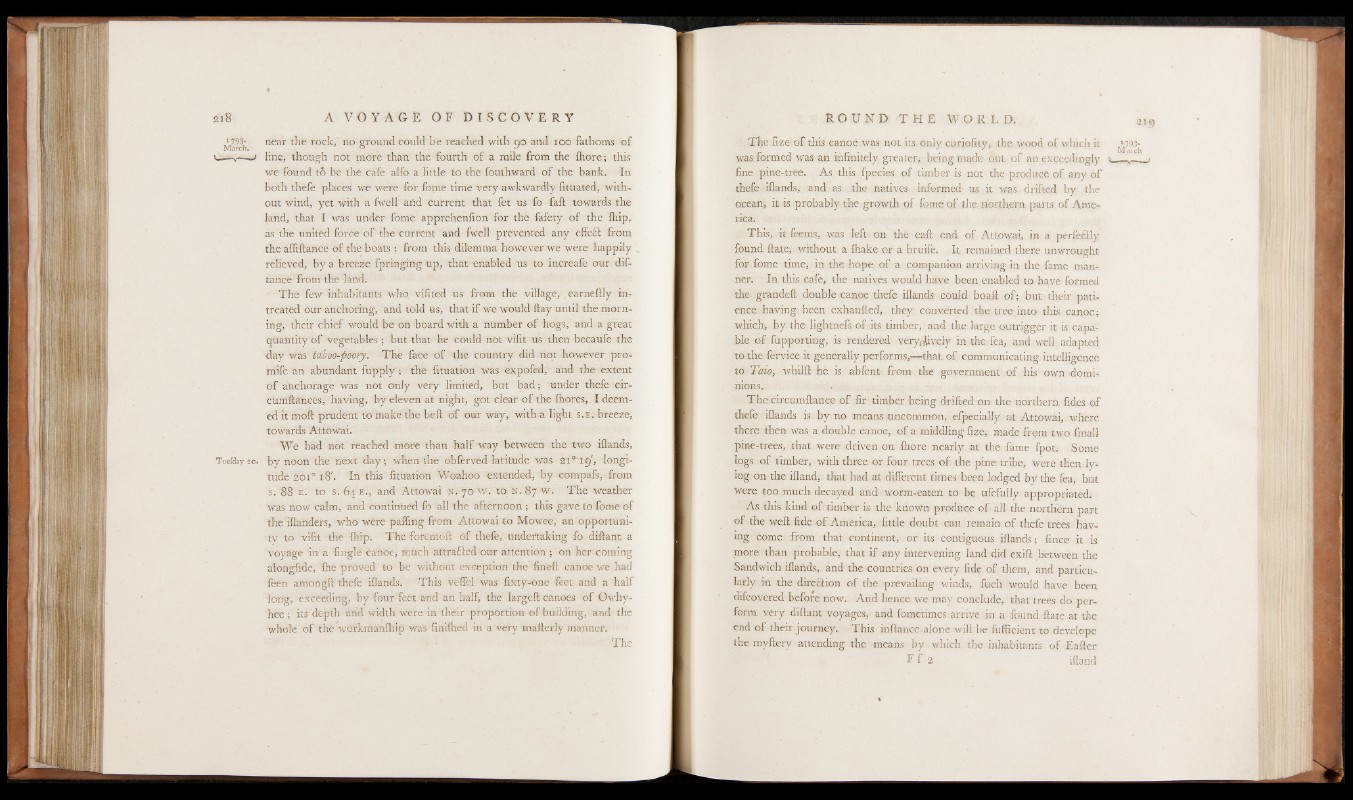
2i8 A V O Y A G E O F D I S C O V E R Y
^793- near the rock,' no ground could be reached with go and too fathoms o f
i__ ___ ; line, though not more than the fourth of a mile from the lhore; this
we found to be the. cafe alfo a little to the fouthward of the bank. In
both thefe places. we were for fome time very awkwardly fituated, without
wind, yet with a fwell and current that fet us fo fall towards the
land, that I was under fome apprehenfion for the fafety o f the lhip,
as the united force o f the current and fwell prevented any effefil from
the affiftance of the boats ; from this dilemma however we were happily
relieved, by a breeze fpringing up, that enabled us to increafe our dif-
tance from the land.
The few inhabitants who vifited us from the village, earnedly in-
treated our anchoring, and told us, that if we would ftay until the morning,
their chief would be on board with a number of hogs, and a great
quantity of vegetables; but that he could not vilit us then becaufe the
day was tdbob-poory. The face of the country did not however pro-
mife an abundant fupp ly; the fituation was expofed, and the extent
o f anchorage was not only very limited, but bad; under thefe cir-
cumftancès, having, by eleven at night, got clear o f the fhores,. I deemed
it moll prudent to make the bell o f our way, with a light s.e. breeze,
towards Attowai.
We had not reached more than half way between the two iflands,
Tuefday 20. by noon the next day; when the obferved latitude was 21“ 19', longitude
201° 18'. In this fituation Woahoo extended, by compafs, from
s. 88 e. to s. 64 e., and Attowai n. 70 w. to n. 87 w . The weather
was now calm, and continued fo all the afternoon ; this gave to fome o f
the iflanders, who were palfmg from Attowai to Mowee, an opportunity
to vilit the lhip. The foremoll o f thefe, undertaking fo diftant a
voyage in a Angle canoe; much attracted our attention ; on her coming
alonglide, Ihe proved to be without exception the fined canoe we had
feen amongd thefe iflands. This velfel was fixty-one feet and a half
long, exceeding, by four feet and an half, the larged canoes o f Owhy-
hee ; its depth and width were in their proportion of building, and the
whole o f the workmanlhip was-finilhed in a very maderly manner.
The
The fize o f this canoe was not its. only curiofity, the wood of which it
was formed was an infinitely greater, being made out of an exceedingly
fine pine-tree. As this fpecies of timber is not the produce of any of
thefe iflands, and as the natives informed us it was drifted by the
ocean, it is probably the growth of feme o f the northern parts of America.
This, it feems, was left on the ead end of Attowai, in a perfe&ly
found date, without a lhake or a bruife. It remained there unwrought
for fome time, in the hope of a companion arriving in the fame manner.
In this cafe, the natives would have been enabled to have formed
the. granded double canoe thefe iflands could boad of; but their patience
having been exhauded, they converted the tree into this canoe;
which, by the lightnefs o f its timber, and the large outrigger it is capable
o f fupporting, is rendered very,lively in the fea, and well adapted
to the fervice it generally performs,— that of communicating intelligence
to Taio, whild he is abfent from the government of his own -dominions.
. . .
The circumdance o f fir timber being drifted on the northern fides of
thefe iflands is by no means uncommon, efpecially at Attowai, where
there then was a double canoe, o f a middling fize, made from two final!
pine-trees, that were driven on Chore nearly at the fame fpot. Some
logs of timber, with three or four trees o f the pine tribe, were then lying
on the ifland, that had at different times been lodged by the fea, but
Were too much decayed and worm-eaten to be ufefully appropriated.
As this kind o f timber is the known produce o f all the northern part
of the wed fide o f America, little doubt can remain o f thefe trees having
come from that continent, or its contiguous iflands; fince it is
more than probable, that if any intervening land did exifl between the
Sandwich iflands, and the countries on every fide o f them, and particularly
in the direftion of the prevailing winds, fuch would have been
difeovered before now. And hence we may conclude, that trees do perform
very diflant voyages, and fometimes arrive in a found date at the
end of their journey. This indance.alone will be fufficient to develope
the myflery attending the means by which the inhabitants of Eader
F f 2 ifland